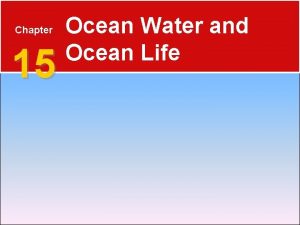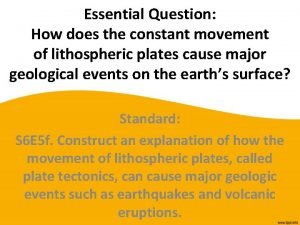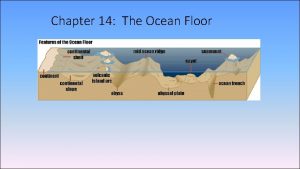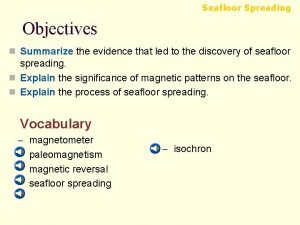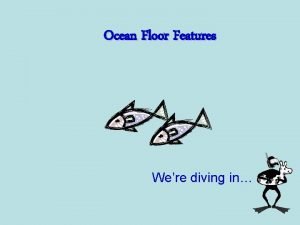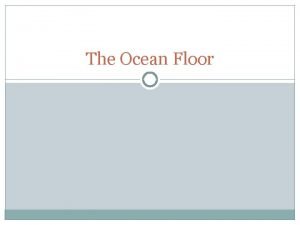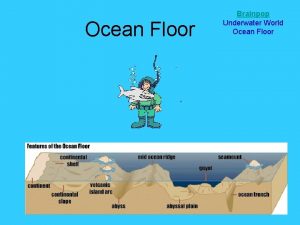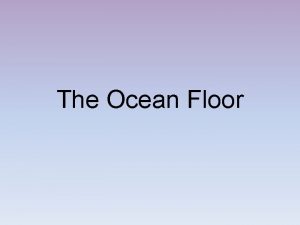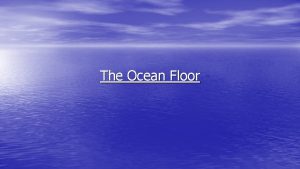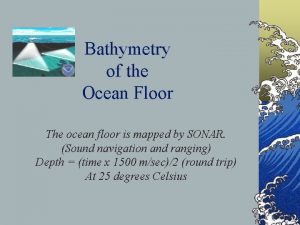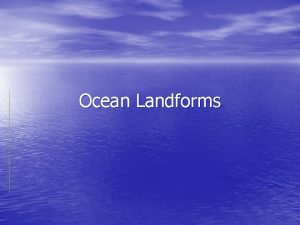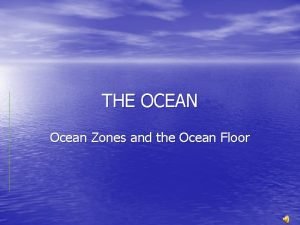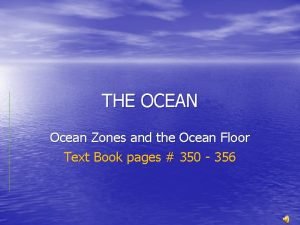THE OCEAN FLOOR Formation of the Ocean Floor











- Slides: 11

THE OCEAN FLOOR

Formation of the Ocean Floor • Ocean floor formation a result of seafloor spreading • Process has been occurring for millions of years • Evidence shown in the symmetrical, parallel bands of basalt that spread out along either side of the ridge • Youngest rocks are closer to the ridge

Features of the Ocean Floor • Ocean basins have the same geological features as continents (i. e. plains, volcanic mountains, valleys) • Far more exaggerated on ocean floor • Average depth of 12, 000 feet • Formation of ocean floor features result of movement in plate tectonics

Features of the Ocean Floor • Subduction Zone – a region of the Earth’s crust where tectonic plates meet • Mountain formation and volcanic activity occur at these zones • Formation of deep ocean trenches • Result of oceanic plate sinking below continental plate

Features of the Ocean Floor • Continental Shelf – a stretch of the seabed adjacent to the shores of a particular country • Extends out under the ocean; geologically part of the continental crust • Area of shallow water known as a shelf sea • Shelves were exposed during glacial periods (15, 000 y. a. )

Features of the Ocean Floor • Continental slope – extent of ocean floor that connects continental shelf to abyssal plain • Abyssal plain – flat and gently sloping areas found at the deepest parts of the ocean • Found at depths between 10, 000 – 20, 000 ft • Covers more than 50% of Earth’s surface • Formed as a result of sediment buildup on the oceanic crust

Features of the Ocean Floor • Abyssal plains contain small hills and underwater volcanic peaks (seamounts) • Peaks of seamounts have been worn down over time to create plateau-like tops (guyots) • A chain of seamounts and volcanic islands can form island arcs • Often occur at subduction zones • Run parallel and close to a plate boundary


Sea Floor Topography • Topography: study of Earth’s surface features, on land on the ocean floor • Topographical maps show seafloor elevation and depressions • Ocean depth can be calculated automatically by sonar • Two pieces of information are needed: the speed of sound in water (1454 m/s) and time it takes for the sound signal to travel • D = 1454 x t/2; D = depth, t = time

Sea Floor Topography • Oceanographers can obtain a profile of the ocean floor by using sonar • Uses sound propagation to detect objects under the surface of water • Most modern ships are equipped with sonar • Series of events with sonar: 1. A ship’s sonar device beams a continuous sound signal downward 2. Sound reaches bottom and returns with an echo 3. Produces a line tracing of the ocean floor

 Formation initiale vs formation continue
Formation initiale vs formation continue Ocean ocean convergent boundary
Ocean ocean convergent boundary Red ocean vs blue ocean
Red ocean vs blue ocean Convergent transform
Convergent transform Chapter 15 ocean water and ocean life
Chapter 15 ocean water and ocean life Ocean ocean convergent boundary
Ocean ocean convergent boundary What type of boundary is the andes mountains
What type of boundary is the andes mountains Convergent plate boundaries
Convergent plate boundaries Ocean to ocean convergent boundary
Ocean to ocean convergent boundary Ocean floor
Ocean floor Chapter 14 the ocean floor answer key
Chapter 14 the ocean floor answer key What is sea-floor spreading? *
What is sea-floor spreading? *




